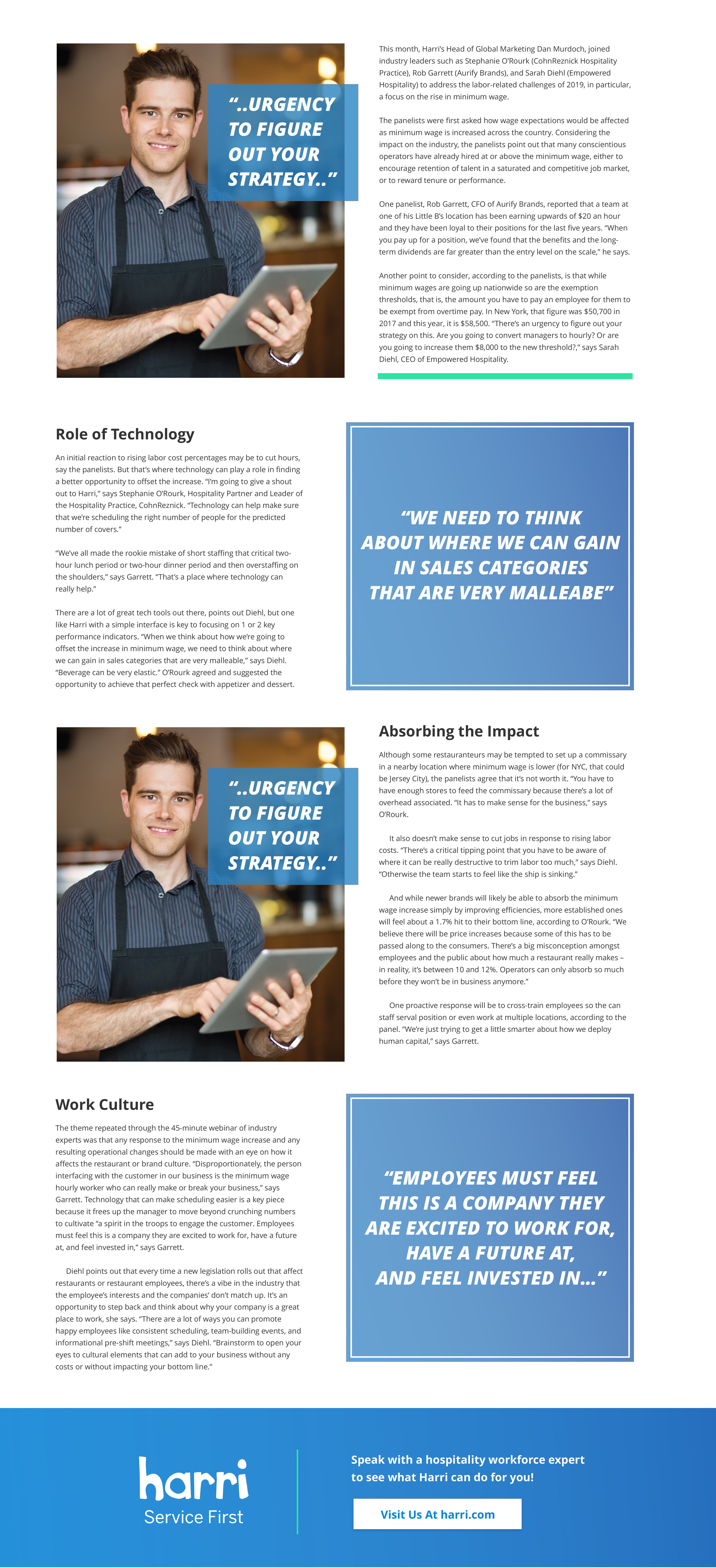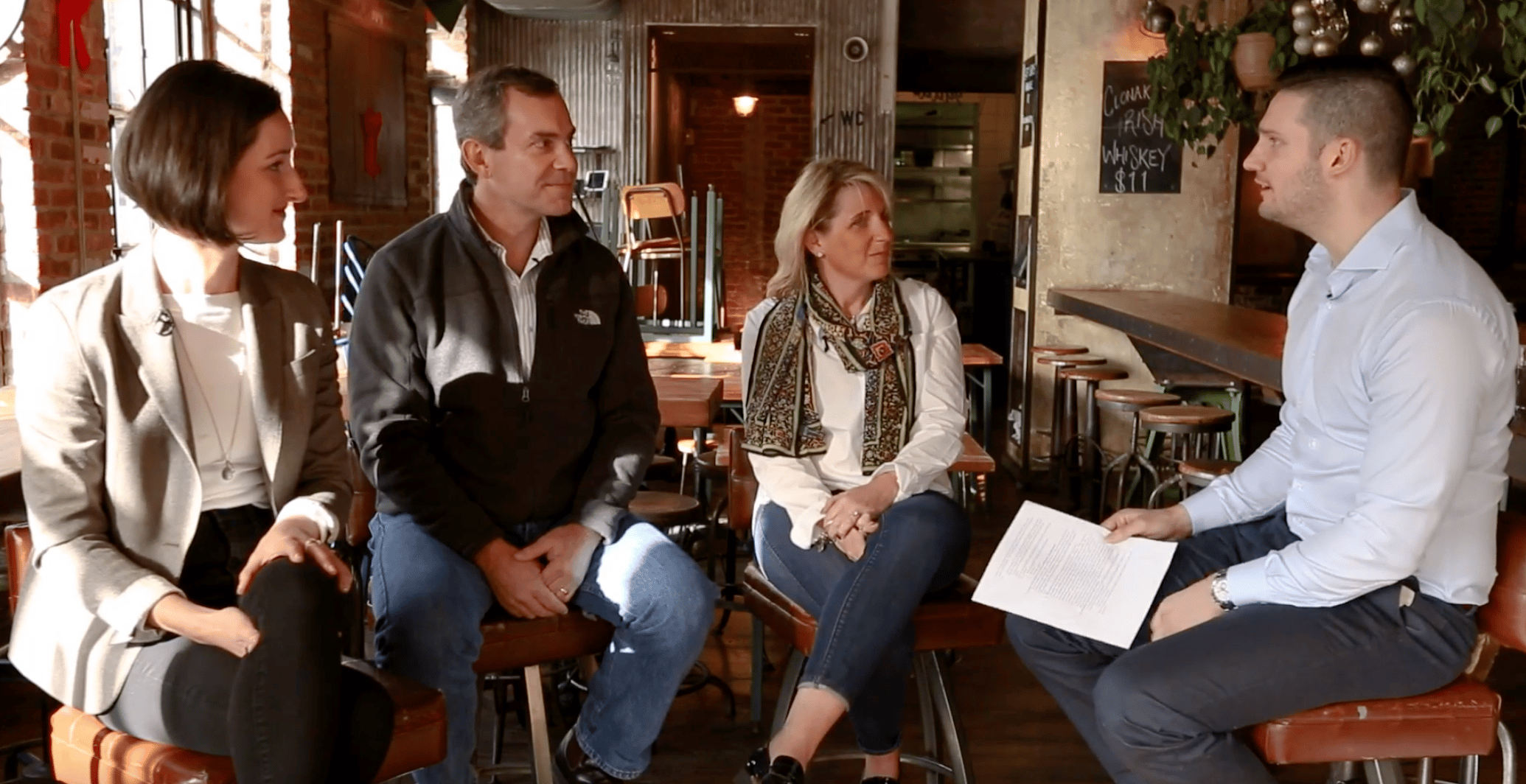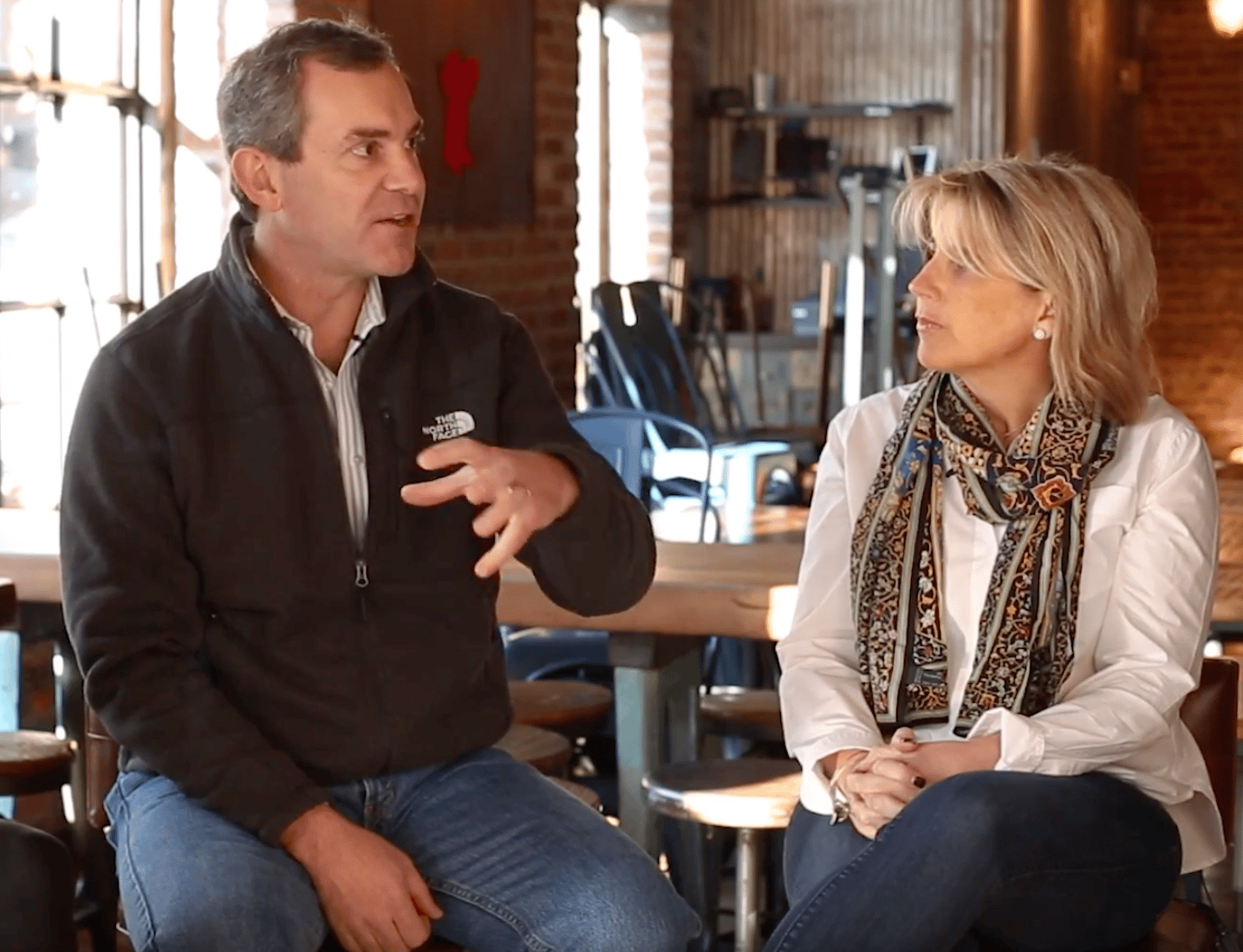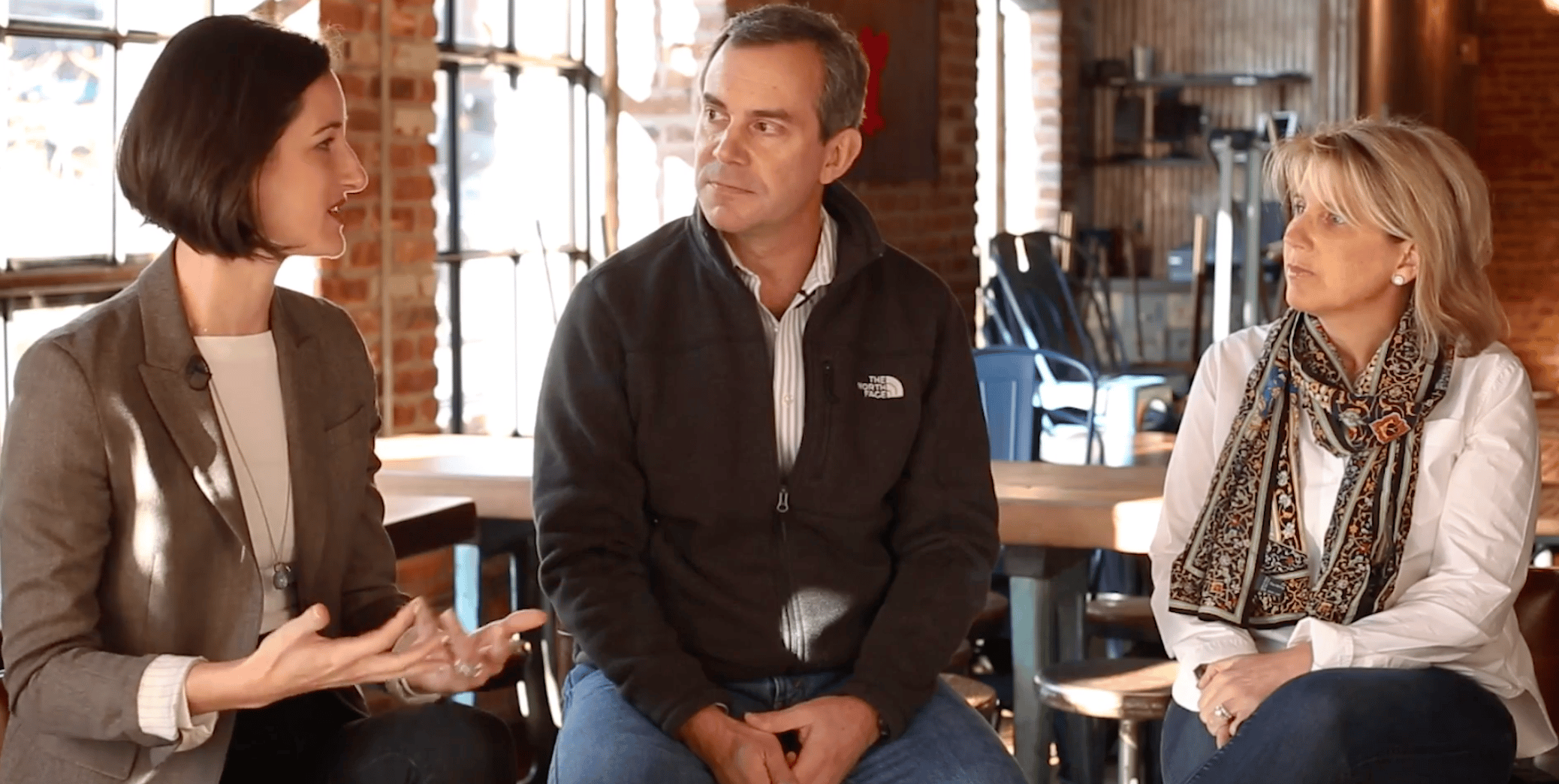
This month, Harri’s Head of Global Marketing Dan Murdoch, joined
industry leaders such as Stephanie O'Rourk (CohnReznick Hospitality
Practice), Rob Garrett (Aurify Brands), and Sarah Diehl (Empowered
Hospitality) to address the labor-related challenges of 2019, in particular,
a focus on the rise in minimum wage.
One panelist, Rob Garrett, CFO of Aurify Brands, reported that a team
at one of his Little B’s location has been earning upwards of $20 an hour
and they have been loyal to their positions for the last five years. “When
you pay up for a position, we’ve found that the benefits and the long-term dividends are far greater than the entry level on the scale,” he says.
Another point to consider, according to the panelists, is that while
minimum wages are going up nationwide so are the exemption thresholds, that is, the amount you have to pay an employee for them to be exempt from overtime pay. In New York, that figure was $50,700 in 2017 and this year, it is $58,500. “There’s an urgency to figure out your strategy on this. Are you going to convert managers to hourly? Or are you going to increase them $8,000 to the new threshold?,” says Sarah Diehl, CEO of Empowered Hospitality.
The panelists were first asked how wage expectations would be affected
as minimum wage is increased across the country. Considering the impact
on the industry, the panelists point out that many conscientious operators have already hired at or above the minimum wage, either to encourage retention of talent in a saturated and competitive job market, or to reward tenure or performance.
Role of Technology
An initial reaction to rising labor cost percentages may be to cut hours,
say the panelists. But that’s where technology can play a role in finding
a better opportunity to offset the increase. “I’m going to give a shout out
to Harri,” says Stephanie O’Rourk, Hospitality Partner and Leader of the Hospitality Practice, CohnReznick. “Technology can help make sure that
we’re scheduling the right number of people for the predicted number
of covers.”
“We’ve all made the rookie mistake of short staffing that critical two -
hour lunch period or two-hour dinner period and then overstaffing
on the shoulders,” says Garrett. “That’s a place where technology
can really help.”
There are a lot of great tech tools out there, points out Diehl, but one like Harri with a simple interface is key to focusing on 1 or 2 key performance indicators. “When we think about how we’re going to offset the increase in minimum wage, we need to think about where we can gain in sales categories that are very malleable,” says Diehl. “Beverage can be very elastic.” O’Rourk agreed and suggested the opportunity to achieve that perfect check with appetizer and dessert.
Although some restauranteurs may be tempted to set up a commissary
in a nearby location where minimum wage is lower (for NYC, that could
be Jersey City), the panelists agree that it’s not worth it. “You have to have enough stores to feed the commissary because there’s a lot of overhead associated. “It has to make sense for the business,” says O’Rourk.
It also doesn’t make sense to cut jobs in response to rising labor costs. “There’s a critical tipping point that you have to be aware of where it can be really destructive to trim labor too much,” says Diehl. “Otherwise the team starts to feel like the ship is sinking.”
And while newer brands will likely be able to absorb the minimum wage increase simply by improving efficiencies, more established ones will feel about a 1.7% hit to their bottom line, according to O’Rourk. “We believe there will be price increases because some of this has to be passed along to the consumers. There’s a big misconception amongst employees and the public about how much a restaurant really makes – in reality, it’s between 10 and 12%. Operators can only absorb so much before they won’t be in business anymore.”
Absorbing the impact
WORK CULTURE
The theme repeated through the 45-minute webinar of industry experts
was that any response to the minimum wage increase and any resulting operational changes should be made with an eye on how it affects the restaurant or brand culture. “Disproportionately, the person interfacing
with the customer in our business is the minimum wagehourly worker who can really make or break your business,” says Garrett. Technology that can make scheduling easier is a key piece because it frees up the manager to
move beyond crunching numbers to cultivate “a spirit in the troops to
engage the customer. Employees must feel this is a company they are
excited to work for, have a future at, and feel invested in,” says Garrett.
Diehl points out that every time a new legislation rolls out that affect restaurants or restaurant employees, there’s a vibe in the industry that the employee’s interests and the companies’ don’t match up. It’s an opportunity to step back and think about why your company is a great place to work,
she says. “There are a lot of ways you can promote happy employees like consistent scheduling, team-building events, and informational pre-shift meetings,” says Diehl. “Brainstorm to open your eyes to cultural elements that can add to your business without any costs or without impacting
your bottom line.”
One proactive response will be to cross-train employees so the can staff
serval position or even work at multiple locations, according to the panel. “We’re just trying to get a little smarter about how we deploy human capital,” says Garrett.
"WE NEED TO THINK
ABOUT WHERE WE
CAN GAIN IN SALES CATEGORIES THAT
ARE VERY MALLEABE"


"..URGENCY TO FIGURE
OUT YOUR STRATEGY.."




"There’s a critical tipping point that
you have to be
aware of"
"EMPLOYEES MUST FEEL
THIS IS A COMPANY THEY ARE EXCITED TO WORK
FOR,HAVE A FUTURE AT,
AND FEEL INVESTED IN..."
WEBINAR RECAP:
Navigating the Rise in Minimum Wage and Labor-Related Challenges
This month, Harri's Head of Global Marketing Dan Murdoch , joined industry leaders
such as Stephanie O'Rourk (CohnReznick Hospitality Practice), Rob Garrett (Aurify
Brands), and Sarah Diehl (Empowered Hospitality) to address the labor-related
challenges of 2019, in particular, a focus on the rise in minimum wage.


Service First

Speak with a hospitality workforce expert to see what Harri can do for you!
LEARN MORE ABOUT HARRI
WATCH THE WEBINAR





WATCH WEBINAR



This month, Harri's Head of Global Marketing
Dan Murdoch , joined industry leaders such as Stephanie O'Rourk (CohnReznick Hospitality Practice), Rob Garrett (Aurify Brands), and Sarah Diehl (Empowered Hospitality) to address the labor-related challenges of 2019, in particular,
a focus on the rise in minimum wage.
WEBINAR RECAP:
Navigating the Rise in Minimum Wage and Labor-Related Challenges

WATCH WEBINAR


Another point to consider, according to the panelists, is that while minimum wages are going up nationwide so are the exemption thresholds, that is, the amount you have to pay an employee for them to be exempt from overtime pay. In New York, that figure was $50,700 in 2017 and this year, it is $58,500. “There’s an urgency to figure out your strategy on this. Are you going to convert managers to hourly? Or are you going to increase them $8,000 to the new threshold?,” says Sarah Diehl, CEO of Empowered Hospitality.
One panelist, Rob Garrett, CFO of Aurify Brands, reported that a team at one of his Little B’s location has been earning upwards of $20 an hour and they have been loyal to their positions for the last five years. “When you pay up for a position, we’ve found that the benefits and the long-term dividends are far greater than the entry level on the scale,” he says.
This month, Harri’s Head of Global Marketing
Dan Murdoch, joined industry leaders such as Stephanie O'Rourk (CohnReznick Hospitality Practice), Rob Garrett (Aurify Brands), and Sarah Diehl (Empowered Hospitality) to address the labor-related challenges of 2019, in particular,
a focus on the rise in minimum wage.
The panelists were first asked how wage expectations would be affected as minimum wage is increased across the country. Considering the impact on the industry, the panelists point out that many conscientious operators have already hired at or above the minimum wage, either to encourage retention of talent in a saturated and competitive job market, or to reward tenure or performance.





"..URGENCY TO FIGURE OUT YOUR STRATEGY.."
There are a lot of great tech tools out there, points out Diehl, but one like Harri with a simple interface is key to focusing on 1 or 2 key performance indicators. “When we think about how we’re going to offset the increase in minimum wage, we need to think about where we can gain in sales categories that are very malleable,” says Diehl. “Beverage can be very elastic.” O’Rourk agreed and suggested the opportunity to achieve that perfect check
with appetizer and dessert.
“We’ve all made the rookie mistake of short staffing that critical two - hour lunch period or two-hour dinner period and then overstaffingon the shoulders,” says Garrett. “That’s a place where technology can really help.”
An initial reaction to rising labor cost percentages may be to cut hours, say the panelists. But that’s where technology can play a role in finding a better opportunity to offset the increase. “I’m going to give a shout out to Harri,” says Stephanie O’Rourk, Hospitality Partner and Leader of the Hospitality Practice, CohnReznick. “Technology can help make sure that we’re scheduling the right number of people for the predicted number of covers.”
Role of Technology
"WE NEED TO THINK
ABOUT WHERE WE
CAN GAIN IN SALES CATEGORIES THAT
ARE VERY MALLEABE"





"There’s a critical tipping point that you have to be aware of"
One proactive response will be to cross-train employees so the can staff serval position or even work at multiple locations, according to the panel. “We’re just trying to get a little smarter about how we deploy human capital,” says Garrett.
And while newer brands will likely be able to absorb the minimum wage increase simply by improving efficiencies, more established ones will feel about a 1.7% hit to their bottom line, according to O’Rourk. “We believe there will be price increases because some of this has to be passed along to the consumers. There’s a big misconception amongst employees and the public about how much a restaurant really
makes – in reality, it’s between 10 and 12%. Operators can only absorb so much before
they won’t be in business anymore.”
It also doesn’t make sense to cut jobs in response
to rising labor costs. “There’s a critical tipping point that you have to be aware of where it can be really destructive to trim labor too much,” says Diehl. “Otherwise the team starts to
feel like the ship is sinking.”
Although some restauranteurs may be tempted to set up a commissary in a nearby location where minimum wage is lower (for NYC, that could be Jersey City), the panelists agree that it’s not worth it. “You have to have enough stores to feed the commissary because there’s a lot of overhead associated. “It has to make sense for the business,” says O’Rourk.
Absorbing the impact




"..URGENCY TO FIGURE
OUT YOUR STRATEGY.."
"EMPLOYEES MUST FEEL
THIS IS A COMPANY THEY ARE EXCITED TO WORK
FOR,HAVE A FUTURE AT,
AND FEEL INVESTED IN..."
Diehl points out that every time a new legislation rolls out that affect restaurants or restaurant employees, there’s a vibe in the industry that the employee’s interests and the companies’ don’t match up. It’s an opportunity to step back and think about why your company is a great place to work, she says. “There are a lot of ways you can promote happy employees like consistent scheduling, team-building events, and informational pre-shift meetings,” says Diehl. “Brainstorm to open your eyes to cultural elements that can add to your business without any costs or without impacting your bottom line.”
The theme repeated through the 45-minute webinar of industry experts was that any response to the minimum wage increase and any resulting operational changes should be made with an eye on how it affects the restaurant or brand culture. “Disproportionately, the person interfacing with the customer in our business is the minimum wagehourly worker who can really make or break your business,” says Garrett. Technology that can make scheduling easier is a key piece because it frees up the manager to move beyond crunching numbers to cultivate “a spirit in the troops to
engage the customer. Employees must feel this is a company they are excited to work for, have a future at, and feel invested in,” says Garrett.
WORK CULTURE

WATCH THE WEBINAR
Speak with a hospitality workforce expert to
see what Harri can do for you!
LEARN MORE ABOUT HARRI
Service First
